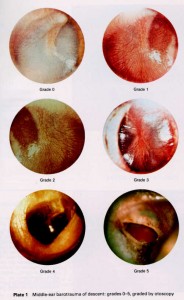Ear Barotrauma For Divers
As a Dive Medical Officer (DMO) in the military I’ve seen a lot of barotrauma. Barotrauma means that there is damage due to the pressure exposures of diving and the inability to ‘clear’ or equalize the pressures as you go deeper.
There are several areas that can be damaged by this pressure and the ears are a very common source. Its the same problem that many people get when they fly.
There are 5 conditions that make barotrauma possible. We use the acronym ‘MARGE’ to help remember them:
- Membrane lined with blood supply
- Ambient pressure change
- Rigid walls
- Gas filled space
- Enclosed space
The pressure in the ears causes some damage which results in a level of bleeding that is generally equivalent to the amount of tissue damage and generally correlated to the pressures experienced.
After these pressures and damage there are often residual symptoms such as pain and pressure in the ear. Generally, these symptoms resolve over time if not reexposed to additional damage. So, how do you know how bad the damage is and how long to avoid diving?
The Teed classification of middle ear ‘squeeze’ or barotrauma helps us classify it:
- Teed 0 – There are symptoms (pain, pressure, etc) but no visual changes in the ear
- Teed 1 – There is vascular congestion of the pars flaccida, umbo, and vascular strip
- Teed 2 – Vascular congestion of the entire tympanic membrane
- Teed 3 – there is hemorrhage (bleeding) within the tympanic membrane
- Teed 4 – there is extensive hemorrhage (bleeding) within the middle ear and the tympanic membrane (TM) may rupture.
- Teed 5 – the middle ear is filled with hemorrhage (bleeding)

Treatment: depends on the severity of the damage and the Teed score. Generally, we will restrict diving until they are healed.
For a Teed 0-1 this is generally 8-72 hours
Teed 2-3 it is generally 1-8 days
Teed 4-5 may take up to 6 weeks if there is a perforation.
Other therapies include oral and topical (nasal) decongestants, pain control, and avoiding diving until its healed. I would consider antibiotics IF the tympanic membrane is ruptured.






